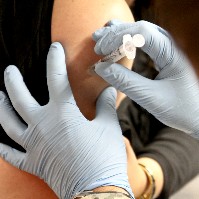Researchers at Wake Forest University in Winston-Salem, North Carolina used an online computer game to simulate an infectious disease epidemic and better understand the motivations behind getting or avoiding preventive actions. The work of Wake Forest economists Frederick Chen, Amanda Griffith, Allin Cottrell, and computer scientist Yue-Ling Wong appear this week in the online journal PLoS One.
The Wake Forest team recruited players to take part in an online multi-player game simulating an epidemic. Simulations are often used to estimate the spread of an epidemic, but they normally require making assumptions in their computational models about the numbers or percentages of people in the population that take preventive measures. This virtual epidemic experiment, however, observed first-hand the way people actually behave when faced with choosing to protect themselves during a widespread occurrence of infection in a community.
The 106 players were divided evenly between two conditions: one where the cost of preventive action was low, and the other where the cost of prevention was high. Because taking precautions against infection involved a cost, players could earn the highest number of points by staying healthy and not choosing the preventative measures. Players knew they would receive a gift card at the end of the game with a value equal to the total number of points earned in the game — an incentive to play honestly. Bonus points were awarded for completing a follow-up questionniare at the end.
The researchers conducted the game in two installments, one for each (low or high-cost) condition. Three players in each condition were randomly selected to be infected in the game’s first round, while the remainder started the game in the healthy state. After conducting the game, the findings show people facing lower costs for preventive measures — those in the game’s lower-cost condition — were significantly more likely to make the choice to protect themselves from infection.
“Players were rolling the dice to see if they could stay healthy without paying the costs of protection,” says Chen, who studies the economic epidemiology. “But even those players who were more inclined to take risks chose to self-protect the more often they got sick.”
Costs for preventive measures include not only out-of-pocket expenses for vaccines, but also fear of negative side effects from taking a vaccination, a fear of needles, lost pay for time away from work, the cost of gasoline for driving to a flu shot center, and the time spent waiting in line for a vaccination. The findings suggest, say the authors, that policies reducing the cost of self-protection, such as offering paid time off for employees to get flu shots or providing free flu shots onsite, can help reduce the prevalence of disease.
Also influencing decisions to take preventive actions was the number of players who had become virtually infected during the game. “At the start of each day, participants could see how many players in the game were infected,” notes Chen. “As the number of sick players increased, more healthy players chose to take the preventative measure.” The findings indicate as well that players who got infected at a higher rate were more likely to take precautionary action in the future and that the willingness to engage in safe behaviors increases or decreases over time depending on the seriousness of the epidemic.
The authors say the results can be applied to many illnesses from the common cold to sexually transmitted diseases, where there are costs, financial or otherwise, to taking preventative measures. “When it comes to policies for disease control, one size does not fit all,” cautions Chen. “Some people are very risk tolerant and some are super risk averse. Our research shows that to prevent an epidemic, there is a need to tailor a menu of options for different kinds of people.”
Read more:
- FDA Extends Flu Therapy Approval for Infants
- Report: Pharmas Increasing Medicine Access in Poor Regions
- Microneedles Found Effective as Syringe for Measles Vaccine
- FDA Approves Cell Culture Seasonal Flu Vaccine
- Math Model Identifies Network Source of Rumors, Epidemics
* * *


 RSS - Posts
RSS - Posts
You must be logged in to post a comment.